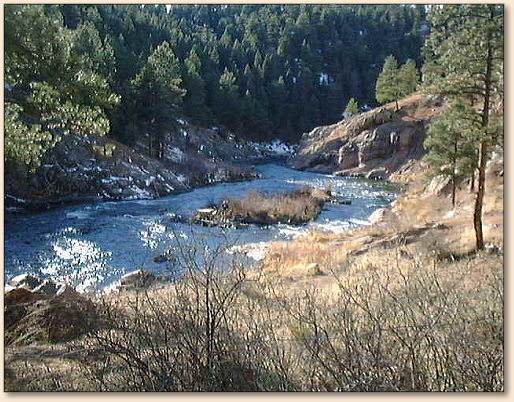Tributary One - Part 2
By Carl Pudlo, Colorado
I worked the streamer down through the deeper holes
created by the flow of the current as it hit the walls
of the bank. The water was clear and higher than normal.
I used fast-water fishing techniques I had learned
through trial and error. The best way I found to work
the water with a streamer was with lots of patience.
I would stand on the inside of a bank and cast at a
forty-five degree angle upstream. The streamer would
drift down, as I applied small jerks to the line to
give action to the maribou-feathered streamer. For
maximum effect, I fished the streamer until the line
extended completely downstream, and then tug a few
times to bring the streamer slowly upstream against
the current. After this, I retrieved the line and
another cast made three feet downstream from the
previous cast. The process is repeated until the
last cast was at a forty-five degree angle downstream,
then I would move about three to four feet downstream
and repeat the cycle. I start this method of fishing
upstream from the hole and continue it until I am at
the downstream side of the hole.
As luck, and weather, would have it, the fishing was
excellent when the sun was behind the cloud cover. We
noticed the fish would tend to stay on the bottom when
the sun appeared. This gave us the opportunity to rest,
relax, and enjoy the surroundings when the sun was out.
As soon as the clouds hid the sun, we were back on the
stream fishing our hand tied flies. As I recall, I had
several successes with smaller fish. I had been casting
as close to the bank as possible and letting the fly drift
toward the middle of the stream. I was expecting most
of the action near the riverbank, and that is where the
action of the smaller trout was taking place. When I got
to the middle of the second stretch of undercut banks,
I was not expecting anything to attack the fly at midstream.
I saw the water break with a swirl of a good fish in the
midst of the rippling water. With fast water, a good fish,
and a 4x tippet, I knew I would have to work the fish
carefully. Since I fish with no backing behind the fly
line, I walked downstream with the fish until I could
safely land the sixteen-inch trout. I was overjoyed;
the first excursion to the South Platte produced a
quality fish. A sixteen-inch trout is not an outstanding
fish, but combined with the strong current and the light
tippet, I enjoyed catching the fish.
My excitement got the best of me. I had to walk the
fish a short distance upstream to Bill and display the
success of my labor. As I got closer to Bill, I could
see he was busy flipping dry flies upstream. He had
only a brief second to turn and glimpse at the fish I
was holding. After Bill got a look at the fish, I
carefully returned it to the stream.
* * * *
I was free for fishing and camping the following weekend.
I had no doubt in my mind where I would fish. The 'first'
experience with the South Platte made me anxious, if not
whole-heartedly determined, to return to that decrepit
railroad bridge. I drove to the same turn-around where
Bill and I had parked the previous week, arriving about
six that evening. The weather was much different this
time. The cloud-filled sky threatened rain. This was
great. I had such a feeling of exhilaration as I readied
the fly rod and waders.
This time, I started fishing further upstream from the
remains of the railroad bridge. I had plenty of fishing
time, so I wanted to fish and explore the river where I
had not previously been. The weather had turned cold
and windy, but I would not have my hopes and dreams of
hunting down a monster trout dampened by wind and rain.
I am always prepared for rain. I carry a rain poncho
in my fishing vest and, as I started fishing downstream,
it was necessary to use the rain poncho. I was pleased.
The weather was cooperating, and the river was clear.
The fishing anticipation was high.
I had fished for over an hour when I arrived at a bend in
the river just upstream from the railroad bridge. As I came
to the deepest undercut in the bank, I was beginning to get
a little discouraged. The wind made casting difficult and
inaccurate. The rain was covering my glasses with droplets
that made visibility unclear. The cold was making my fingers
numb. I fought off discouragement with the thought that
somewhere on this bend was a fish that I would like to have
hanging on my wall in a mount that would make any fisherman
envious. As with most fishing, persistence paid off. I saw
a strike just off the edge of the undercut bank. As I set
the hook, I knew this was a good fish. The fish stayed deep
in the water. My biggest fear was the fish would head
downstream to the bridge and wrap itself around one of the
log pillars. It started to go that direction but inexplicably
turned around and headed upstream. I was able to land the
large brown trout without the aid of a net. The streamer
hooked the fat trout in the roof of the mouth. A best
estimate revealed the trout just short of 20 inches in length,
but the girth suggested the trout might approach the four-pound
mark. Not being sure of the size, I released the trout. I
immediately promised myself some day I would return to this
section of the South Platte and would catch a trout that
would hang from my wall. I have had more enjoyment returning
to Hartsel in anticipation of catching a 'wall' trout than I
have ever had in the actual catching of trout. This experience
has always reminded me that the hunt is always more pleasing
than the actual success.
* * * *
As Bill and I recounted the 'first' fishing experience on
the South Platte, we noted the beauty of the area more than
the fishing itself. The vast high plain setting with the
distant views of both mountains and bluffs would keep us
talking for the hour drive back to the campsite. We noted
the sound of the water as it rippled past the rocks. We
mused over the decrepit railroad bridge, the smell of the
grasses and flowers of the meadow, and the feel of the wind
as it raced across the plain. The most vivid memory I have
of the first fishing experience on the South Platte was the
weather. I have not seen the same conditions on that stretch
of the South Platte since the first day I fished it with Yooper
Bill. The near and distant rain clouds, the recurring lightning,
and the booming thunder stands out as a memorable experience.
Since that day, I have fished that stretch many times. I still
enjoy fishing there. Each time I fish there, my mind wanders
as I fish the many rippled stretches, the undercut banks, and
the slow meandering corners. Whenever I fish there, I recall
the 'first' encounter of fishing the South Platte at Hartsel.

To be continued. ~ Carl Pudlo, Colorado
The South Platte Chronicles Archive
|

